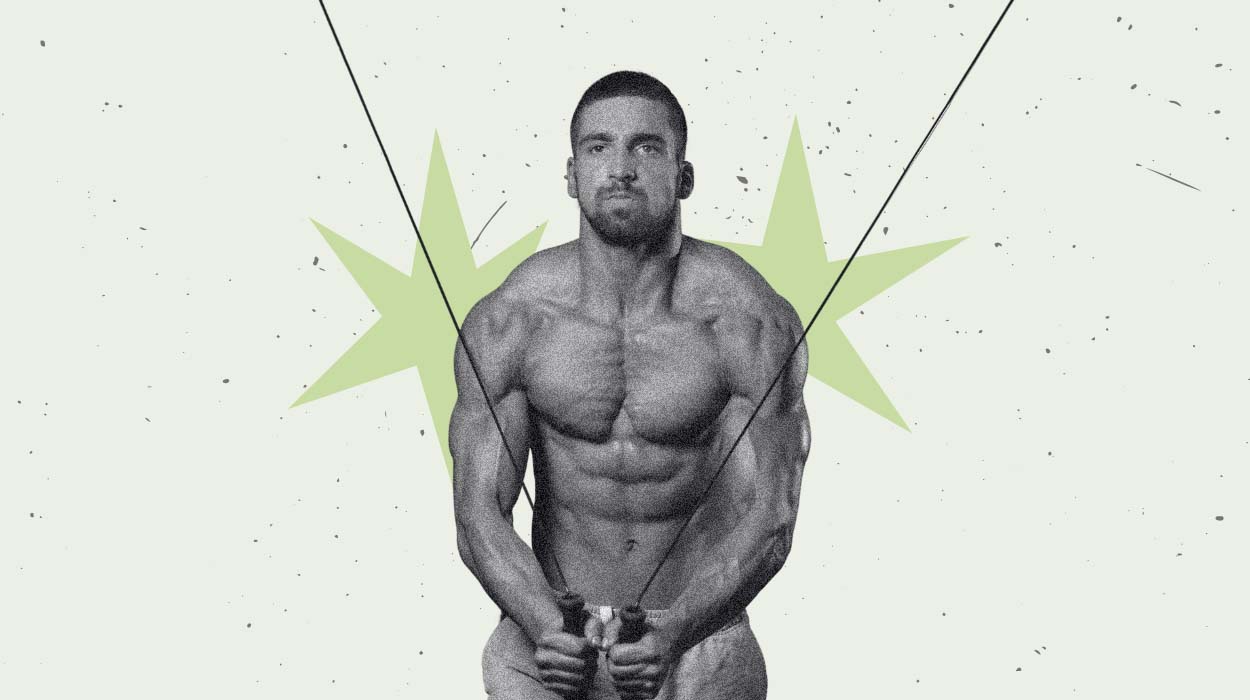
Are you looking to sculpt strong, defined shoulders that turn heads? If so, cable shoulder workouts might just be your secret weapon. With their ability to engage multiple muscle groups and provide constant tension, cable exercises offer a myriad of benefits for developing well-rounded shoulder strength, stability, and aesthetics.
Whether you’re a fitness enthusiast, an athlete seeking functional strength, or someone recovering from a shoulder injury, shoulder cable exercises can provide the edge you need. Join us as we dive into the top reasons why incorporating cable shoulder exercises into your fitness routine is a game-changer.
Get ready to unleash the full potential of your shoulder muscles and achieve your fitness goals!
Best Cable Shoulder Exercises
Here is a bullet-point list of the shoulder exercises discussed in the article:
Remember to choose appropriate weights, maintain proper form, and gradually increase resistance as you progress.
Cable Shoulder Workouts
Single Cable Overhead Press
The Single Cable Overhead Press is a unilateral shoulder exercise that targets the deltoids, triceps, and core muscles.
This exercise helps improve shoulder strength, stability, and muscular balance. It also engages the core as you resist rotational forces. The Single Cable Overhead Press is a versatile exercise that can be incorporated into full-body workouts or focused shoulder training sessions.
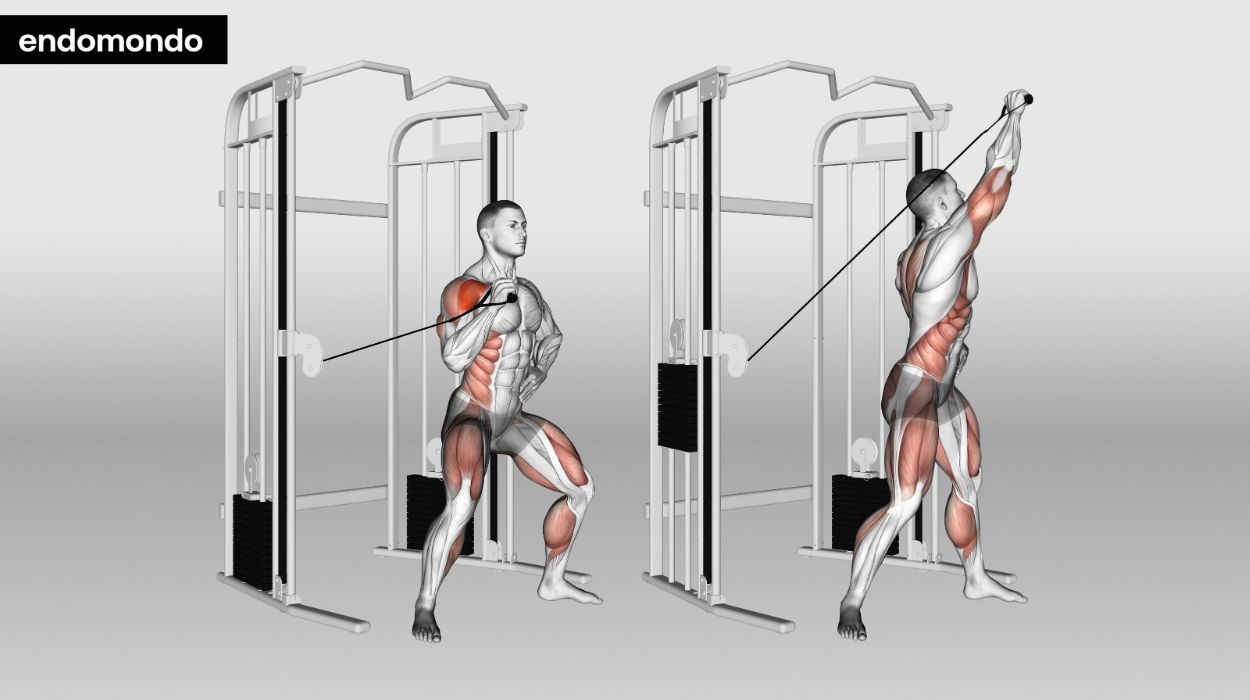
How to do:
- Stand with one foot forward, holding a cable handle opposite hand.
- Start with the elbow bent at 90 degrees, hand by the shoulder.
- Press the cable upward, fully extending the arm with control.
Tips:
- Maintain a staggered stance with one foot forward for balance and stability.
- Push the cable upwards smoothly, focusing on engaging your shoulder muscles without using momentum.
- Keep your core tight throughout the exercise to support your upper body and prevent arching of the back.
Optimal Sets and Reps: Perform 3 to 4 sets of 8 to 12 reps on each arm.
Dual Cable Overhead Press
The Dual Cable Overhead Press is a dynamic shoulder exercise that targets the deltoids, triceps, and core muscles. This exercise promotes symmetrical shoulder development, enhances upper body strength, and improves shoulder stability and control.
The dual cables provide resistance throughout the movement, challenging your muscles in a balanced and controlled manner. Incorporate the Dual Cable Overhead Press into your upper body workouts for well-rounded shoulder strength and stability.
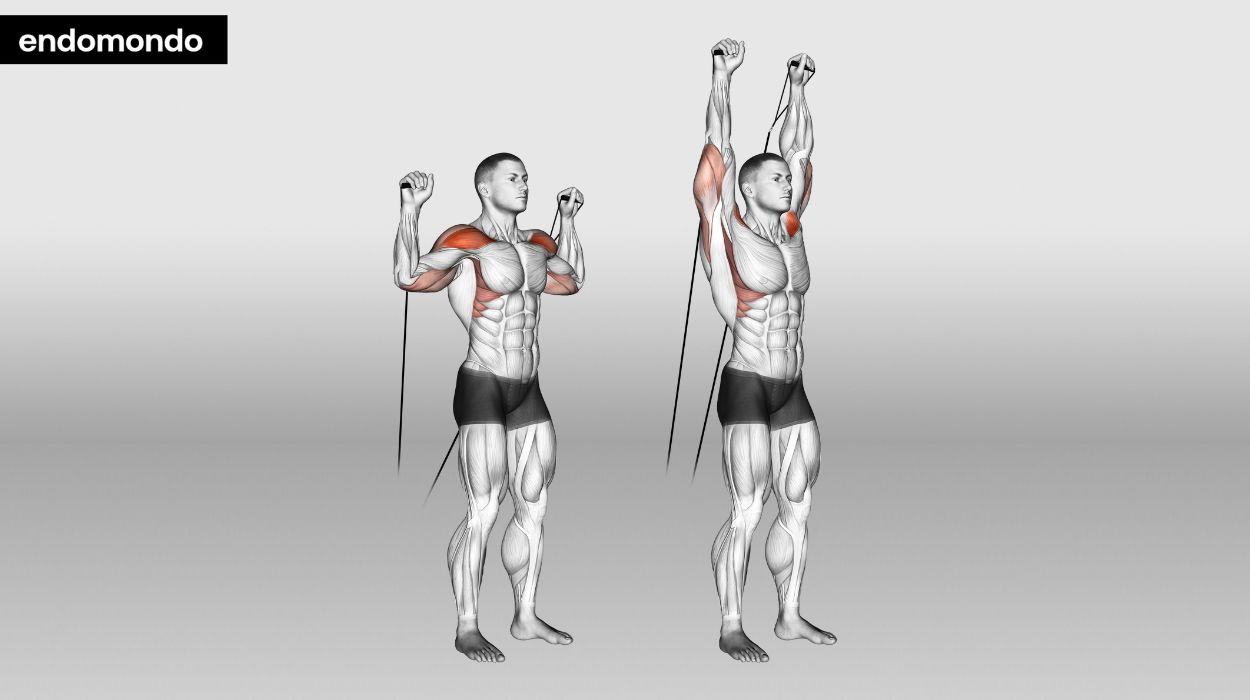
How to do:
- Stand in a split stance or with feet shoulder-width apart.
- Grasp a cable handle in each hand, hands at shoulder height.
- Begin with elbows bent at 90 degrees.
- Press cables overhead simultaneously, fully extending arms.
- Maintain control and stability throughout the movement.
Tips:
- Apply equal pressure with both arms to ensure symmetrical muscle development.
- Focus on using your shoulder muscles while keeping your core engaged for stability.
- Avoid jerky motions; press up smoothly and lower the cables back with control.
Optimal Sets and Reps: Aim for 3 to 4 sets of 10-12 reps each.
Kneeling Shoulder Press
The kneeling shoulder press is a variation of the overhead press that adds an element of stability and core engagement. By performing the exercise in a kneeling position, you eliminate the possibility of using momentum and force your core to work harder to maintain balance.
This exercise targets the deltoids, triceps, and core muscles. It can be particularly beneficial for individuals looking to improve their upper body strength and stability, as well as those recovering from shoulder injuries or working on shoulder rehabilitation.
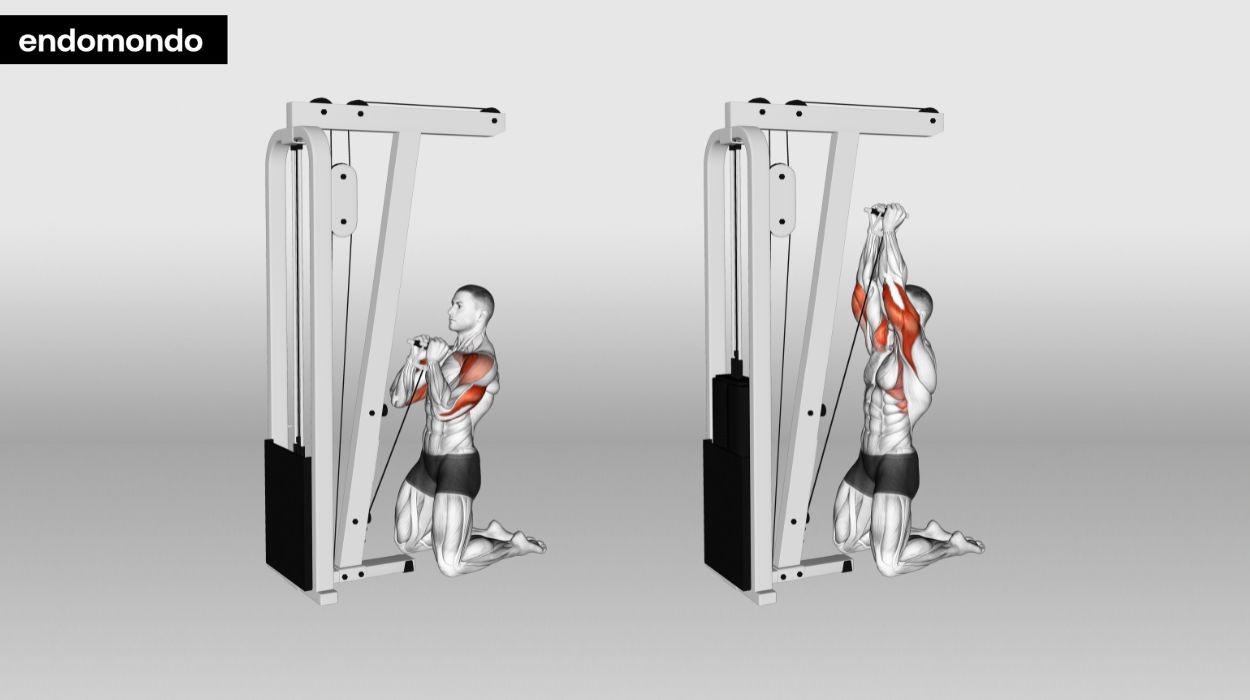
How to do:
- Kneel facing the cable machine, cable at shoulder height.
- Attach the handle; grasp it with one hand.
- Align hand with shoulder, elbow bent, palm facing forward.
- Press the handle upward, extending your arm fully.
- Slowly return to the starting position, maintaining control.
Tips:
- Ensure your knees are comfortably cushioned and maintain a stable base throughout the exercise.
- Actively tighten your core and glutes to support your upper body and enhance stability during the press.
- Focus on a smooth, controlled press and equally controlled return to maximize shoulder muscle engagement.
Optimal Sets and Reps: Perform 3 to 4 sets of 8 to 12 reps for each arm.
Seated Cable Military Press
The seated cable military press is a seated variation of the overhead press that utilizes cable resistance. By performing the exercise in a seated position, you stabilize your body and isolate the shoulder muscles.
This exercise primarily targets the deltoids and triceps while engaging the core for stability. The cable resistance allows for a smooth and continuous range of motion, providing constant tension on the muscles throughout the exercise.
The seated position also helps maintain proper form and reduces the risk of using momentum to lift the weights, making it an effective exercise for developing shoulder strength and stability.
How to do:
- Sit on the bench, back straight, facing the cable machine.
- Grasp the cable handles at shoulder height, palms facing forward.
- Press the handles upward, fully extending your arms overhead.
- Pause briefly at the top of the movement.
- Slowly lower handles back to shoulder height.
Tips:
- Always focus on maintaining proper form to prevent injuries and ensure targeted muscle engagement.
- Lift and lower weights in a controlled manner, avoiding using momentum to complete the movement.
- Inhale during the easier part of the lift and exhale during the more challenging part to maintain energy and stability.
Optimal Sets and Reps: Aim for 3 to 4 sets of 6 to 12 reps per exercise.
Cable Lateral Raise
The cable lateral raise is an effective exercise for targeting the lateral deltoids. By attaching the cables to a low setting and lifting them out to the sides, you engage and strengthen the middle portion of your shoulder muscles. This exercise helps in developing wider and more defined shoulders.
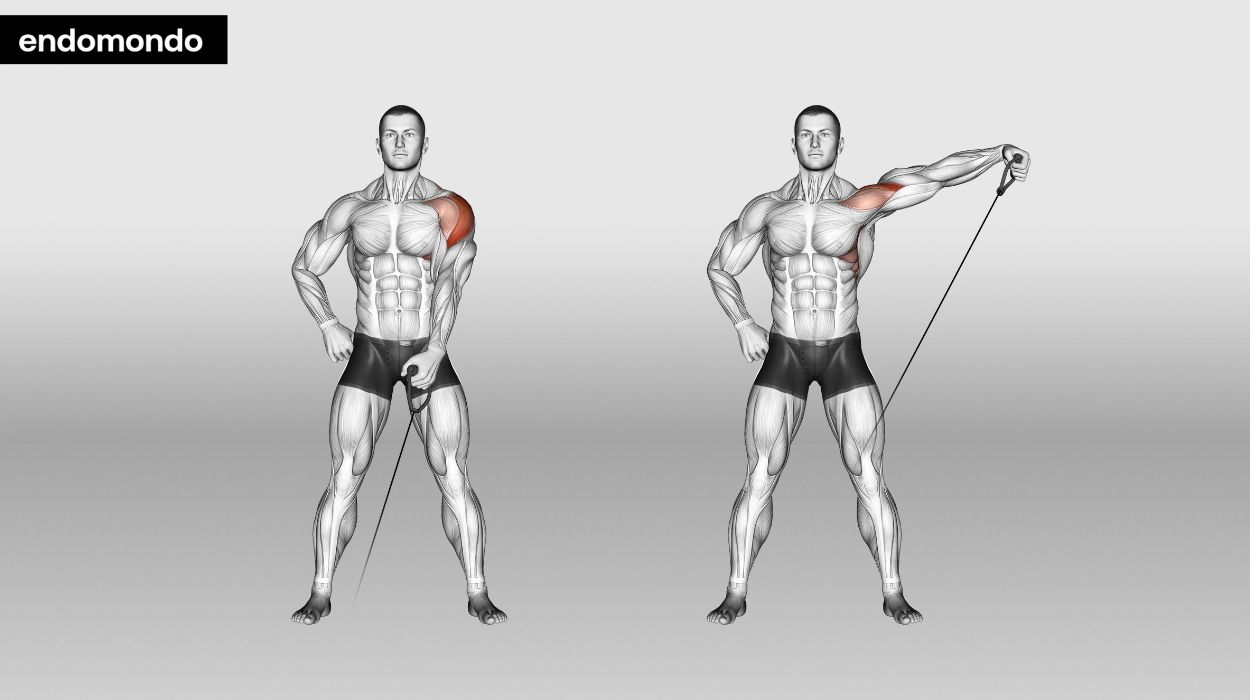
How to do:
- Stand beside the cable machine, handle at the lowest setting.
- Grasp the handle with the hand farthest from the machine.
- Keep the arm slightly bent, and the elbow and wrist straight.
- Raise arm to shoulder height, maintaining control.
- Slowly lower back to the starting position.
Tips:
- Stand with a slight bend in the knees and core engaged to maintain balance.
- Raise the cable smoothly to shoulder height and lower back down with control, avoiding jerky movements.
- Concentrate on using your shoulder muscles to lift the weight, not your momentum or other muscles.
Optimal Sets and Reps: Aim for 3 to 4 sets of 8 to 12 reps each.
Cable Face Pull
The cable face pull is a great exercise for targeting the rear deltoids, rhomboids, and upper back muscles. Attach a rope handle to a cable machine at chest height. Stand facing the machine, grab the handles with an overhand grip, and pull them towards your face while keeping your elbows high and wide. This exercise helps improve posture, strengthen the rear deltoids, and promote balanced shoulder development.
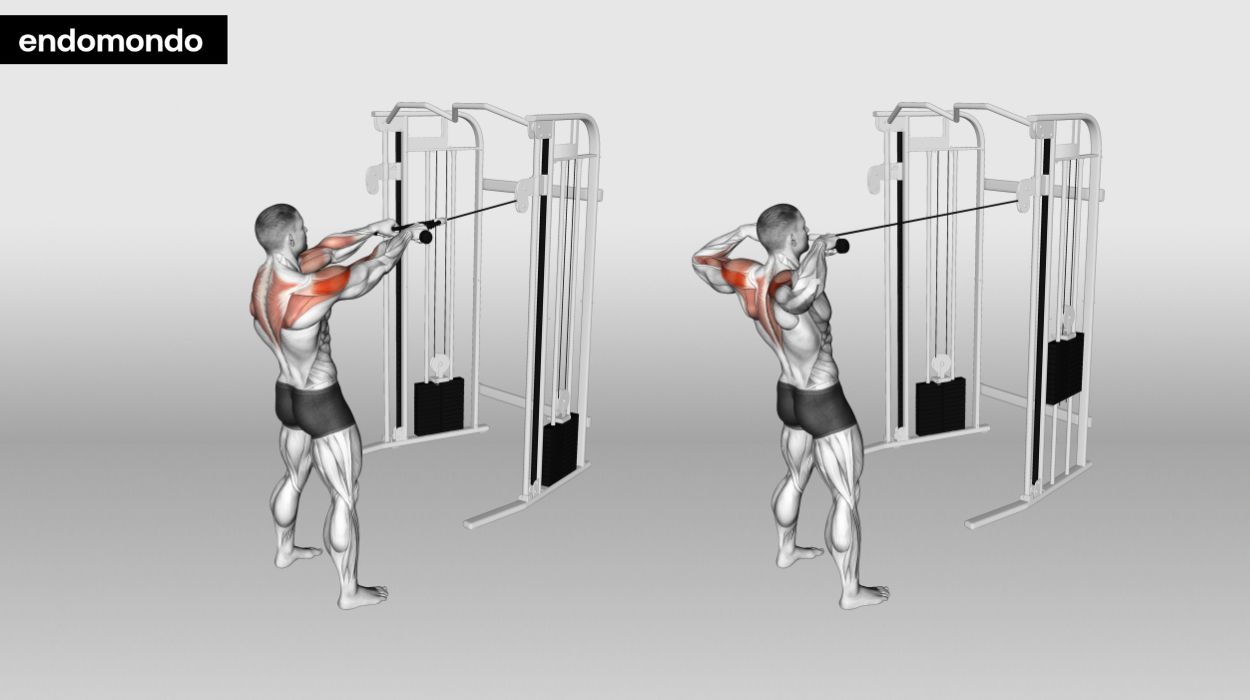
How to do:
- Set the cable to upper chest height with a rope attachment.
- Stand facing the machine, and grab the rope with both hands.
- Step back slightly, maintaining a staggered stance for balance.
- Pull the rope towards the face, separating hands as you pull.
- Control the return movement to the starting position.
Tips:
- Focus on using your rear deltoids and upper back muscles, not just your arms.
- Maintain your elbows at shoulder height throughout the movement to effectively target the shoulders and upper back.
- Pull the cable towards your face slowly and return to the starting position with control to maximize muscle engagement.
Optimal Sets and Reps: Perform 3 to 4 sets of 10-15 reps each.
Cable Rear Delt Fly
The cable rear delt fly is another effective exercise for targeting the posterior deltoids. Stand facing away from the cable machine, grab the handles with an overhand grip, and bring your arms forward and out to the sides, squeezing your shoulder blades together. This movement activates the rear deltoids, helping to improve shoulder strength and posture.
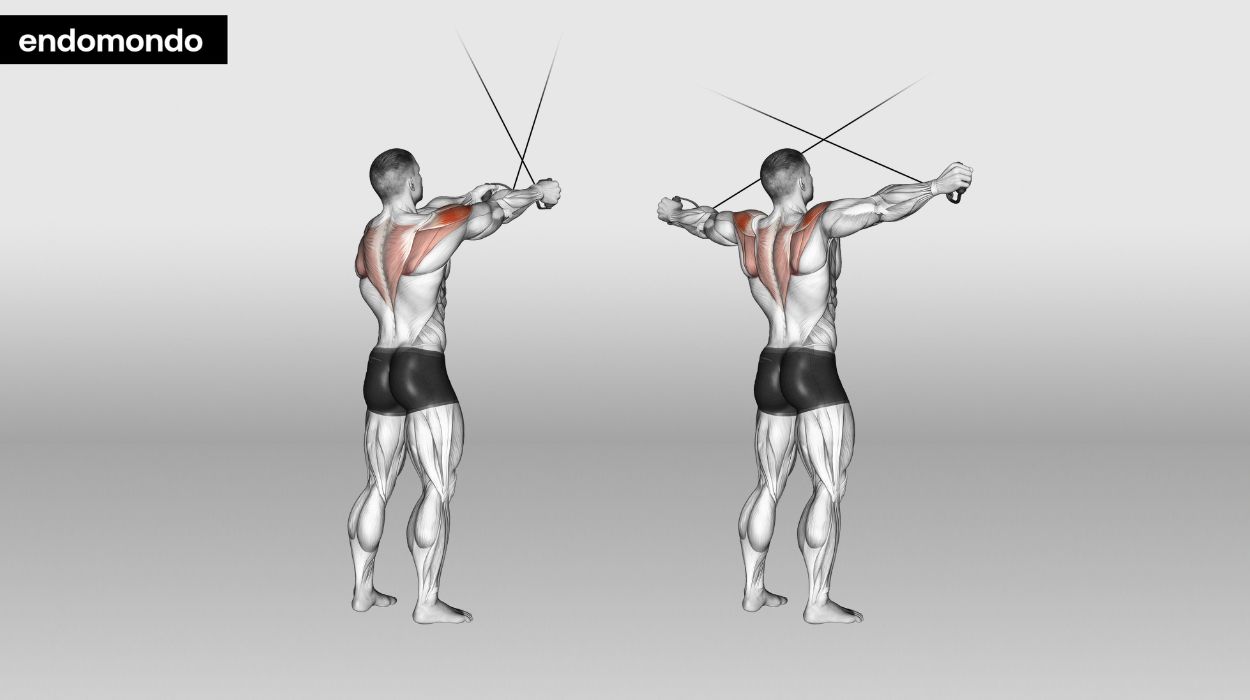
How to do:
- Set dual cables to shoulder height, and stand in the middle.
- Grasp opposite handles in each hand, crossing arms in front.
- Step back into a staggered stance for stability.
- Extend arms out to sides, keeping elbows slightly bent.
- Slowly return to the starting position, controlling the movement.
Tips:
- Concentrate on squeezing your shoulder blades together at the end of the movement to fully engage the rear deltoids.
- Move your arms slowly and deliberately, avoiding any jerky or momentum-driven movements to maintain tension in the muscles.
- Keep your back straight and core engaged throughout the exercise to support your upper body and prevent injury.
Optimal Sets and Reps: Aim for 3 to 4 sets of 10-12 reps each.
Shoulder Workouts On Cable Machine: Muscles Worked
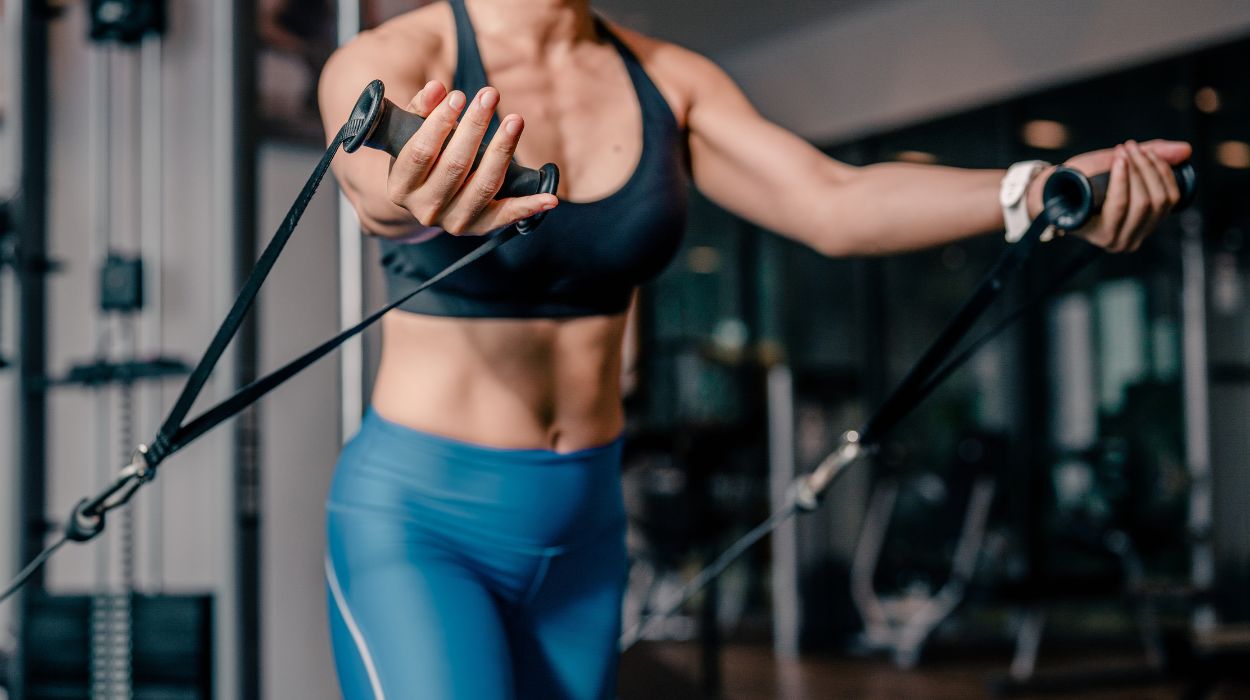
When it comes to building strong and well-defined shoulders, cable exercises can be highly effective. The constant tension provided by the cable machine helps target specific muscles in the shoulder complex, allowing for greater activation and muscle development.[1] In this article, we will explore some of the best cable shoulder exercises and the muscles they target.
Cable Shoulder Press
The cable shoulder press primarily targets the anterior deltoids, which are the front portion of the shoulder muscles. This exercise also engages the lateral deltoids (middle part of the shoulders) and the triceps as stabilizing muscles.
How to do:
- Set cables to shoulder height with handles attached.
- Stand in the middle, grasping each handle at shoulder level.
- Position feet shoulder-width apart for stability.
- Press the handles straight up overhead, fully extending arms.
- Slowly lower back to shoulder height, controlling the descent.
Tips:
- Stable Stance: Keep your feet firmly planted and maintain a slight bend in the knees for stability.
- Controlled Motion: Push the handles upward smoothly, focusing on engaging your shoulder muscles without using momentum.
- Even Distribution: Apply equal pressure with both arms throughout the movement for balanced shoulder development.
Optimal Sets and Reps: Perform 3 to 4 sets of 8 to 12 reps each.
Cable Lateral Raise
The cable lateral raise is an excellent exercise for targeting the lateral deltoids, which contribute to the width and roundness of the shoulders. This movement primarily involves lifting the cables out to the sides while keeping the arms slightly bent.
How to do:
- Stand next to the machine, and handle it at a low position.
- Grasp the handle with the hand furthest from the machine.
- Keep a slight bend in your elbow and body upright.
- Lift arm to shoulder height, keeping movement controlled.
- Slowly lower back to the starting position.
Tips:
- Maintain Posture: Keep your body straight and avoid leaning to ensure targeted shoulder activation.
- Controlled Movement: Lift and lower the handle in a smooth, controlled manner to maintain tension on the shoulder muscles.
- Focus on Shoulders: Concentrate on lifting with your deltoid muscle, avoiding using momentum or other muscle groups.
Optimal Sets and Reps: Aim for 3 to 4 sets of 10-15 reps on each side.
Cable Front Raise
The cable front raise focuses on the anterior deltoids, providing a great exercise for the front portion of the shoulders. By attaching the cable handle at a low setting, you can perform front raises that target the deltoids in a slightly different way compared to traditional dumbbell front raises.
How to do:
- Stand-facing cable machine, handle attached at low setting.
- Grasp the handle with one hand, arm extended.
- Keep body stable, feet shoulder-width apart.
- Raise arm straight in front to shoulder height.
- Lower arm back down in a controlled manner.
Tips:
- Maintain Steady Posture: Keep your body steady and avoid leaning back as you raise the cable.
- Controlled Motion: Lift and lower the handle in a slow, controlled manner to effectively work the shoulder muscles.
- Keep Arm Alignment: Ensure your arm moves straight up and down, maintaining a slight bend in the elbow to protect the joint.
Optimal Sets and Reps: Perform 3 to 4 sets of 8 to 12 reps per arm.
Cable Rear Delt Fly
To target the posterior deltoids, or the rear part of the shoulder muscles, the cable rear delt fly is an effective exercise. By attaching the cables at a low setting and bending forward slightly, you can perform a reverse fly motion, squeezing the shoulder blades together.
How to do:
- Set dual cables to chest height, facing away from the machine.
- Grasp each handle with the opposite hand (cross arms).
- Lean forward slightly, keeping back straight.
- With a slight bend in elbows, pull cables outward and back.
- Return to the starting position with controlled movement.
Tips:
- Keep Shoulders Stable: Focus on moving from the shoulders, avoiding excessive movement in the torso or arms.
- Controlled Movement: Perform the fly movement slowly and with control, ensuring tension remains on the rear deltoids.
- Proper Elbow Bend: Maintain a consistent, slight bend in the elbows throughout the exercise to protect the joints.
Optimal Sets and Reps: Aim for 3 to 4 sets of 8 to 12 reps.
Cable Upright Row
The cable upright row targets both the lateral deltoids and the trapezius muscles. This shoulder cable workout exercise involves pulling the cables upwards towards the chin, keeping the elbows high and wide. It can help develop overall shoulder and upper back strength.
How to do:
- Stand-facing cable machine, rope attachment at low setting.
- Grasp rope with both hands, palms facing each other.
- Stand straight, feet shoulder-width apart.
- Pull the rope upwards towards the chin, elbows leading.
- Lower back down slowly, controlling the movement.
Tips:
- Elbow Alignment: Keep your elbows higher than your forearms during the lift to properly engage the shoulder muscles.
- Avoid Shrugging: Focus on lifting with your arms and shoulders, not by shrugging, to prevent strain on the neck.
- Controlled Pace: Lift and lower the rope smoothly and with control, avoiding jerky movements.
Optimal Sets and Reps: Aim for 3 to 4 sets of 8 to 12 reps each.
Cable Face Pull
The cable face pull is a fantastic exercise for targeting the rear deltoids, rhomboids, and upper back muscles. By pulling the cables towards your face, you engage the posterior deltoids while also working on scapular retraction.
Incorporating cable shoulder workouts into your routine can help you develop well-rounded and strong shoulder muscles. However, it’s essential to maintain a balanced workout program that includes exercises for all the major muscle groups to ensure overall strength and stability.
How to do:
- Adjust the cable to eye level, and attach the rope handle.
- Stand facing the machine, and grip the rope with both hands.
- Pull rope towards the face, elbows moving outwards.
- Squeeze shoulder blades together at peak contraction.
- Slowly return to the starting position, maintaining tension.
Tips:
- Engage the Right Muscles: Focus on using your rear deltoids and upper back muscles, not just your arms.
- Keep Elbows High: Maintain your elbows at shoulder height throughout the movement to effectively target the shoulders and upper back.
- Controlled Tempo: Pull the cable towards your face slowly and return to the starting position with control to maximize muscle engagement.
Optimal Sets and Reps: Perform 3 to 4 sets of 10-15 reps each.
Reasons For Doing Cable Shoulder Workouts

Cable shoulder workouts offer numerous benefits that make them worth incorporating into your exercise routine. Here are several reasons why you should consider doing cable shoulder workouts:
- Muscle Activation[2]: Cable exercises provide constant tension throughout the range of motion, leading to greater muscle activation in the shoulder complex.
- Balanced Development: Cables allow for independent movement of each arm, promoting balanced development of the shoulder muscles.
- Range of Motion: Cable machines offer adjustable pulley heights and angles, allowing you to perform shoulder exercises in various planes of motion.
- Stability & Core Engagement: Cable shoulder exercises require stability and core engagement to maintain proper form and control movement.
- Injury Prevention[3]: Strengthening the shoulder muscles through shoulder cable workouts can help reduce the risk of shoulder injuries.
- Functional Strength[4]: Strong shoulders are essential for performing everyday activities and sports-related movements.
- Versatility: Cable machines offer a wide range of exercises that target various shoulder muscles.
Remember to start with an appropriate weight, maintain proper form, and gradually increase the resistance as your strength improves. Consulting a fitness professional can also guide exercise selection and technique.
Conclusion
Cable shoulder workouts provide a range of benefits that make them a valuable addition to any exercise routine. The constant tension offered by cable machines ensures optimal muscle activation throughout the shoulder complex, promoting balanced development and range of motion.
These exercises also engage stability and core muscles, aiding in injury prevention and enhancing functional strength. With versatile exercises targeting specific shoulder muscles, cable workouts offer a comprehensive approach to shoulder training. Including cable shoulder workouts can lead to well-defined and strong shoulders, essential for everyday activities and sports-related movements.
Frequently Asked Questions
Cable shoulder workouts offer benefits such as greater muscle activation, balanced development, increased range of motion, stability and core engagement, injury prevention, functional strength, and exercise versatility.
The cable shoulder press primarily targets the anterior deltoids (front shoulder muscles) while also engaging the lateral deltoids and triceps as stabilizing muscles.
The cable lateral raise targets the lateral deltoids, which contribute to the width and roundness of the shoulders.
You can target the rear deltoids by performing the cable rear delt fly. By attaching the cables at a low setting and bending slightly forward, you can squeeze the shoulder blades together, activating the posterior deltoids.
The cable upright row engages both the lateral deltoids and trapezius muscles. It involves pulling the cables upwards towards the chin while keeping the elbows high and wide.
The cable face pulls and the cable rear delt fly are both effective exercises for targeting the rear deltoids, rhomboids, and upper back muscles. They involve pulling the cables towards the face and bringing the arms forward and out to the sides, respectively.
Resources
- LWW. (2024). A KINETIC AND ELECTROMYOGRAPHIC COMPARISON OF THE STANDING… : The Journal of Strength & Conditioning Research. [online] Available at: https://journals.lww.com/nsca-jscr/Abstract/2007/11000/A_KINETIC_AND_ELECTROMYOGRAPHIC_COMPARISON_OF_THE.50.aspx
- Signorile, J.F., Rendos, N.K., Heredia, H.H., Alipio, T.C., Regis, R.C., Moataz Eltoukhy, Nargund, R.S. and Romero, M.A. (2017). Differences in Muscle Activation and Kinematics Between Cable-Based and Selectorized Weight Training. Journal of Strength and Conditioning Research, [online] 31(2), pp.313–322. doi:https://doi.org/10.1519/jsc.0000000000001493.
- Lehman, G.J. (2006). Resistance training for performance and injury prevention in golf. The Journal of the Canadian Chiropractic Association, [online] 50(1), pp.27–42. Available at: https://www.ncbi.nlm.nih.gov/pmc/articles/PMC1839980/.
- Balachandran, A., Martins, M., Frederico, Alan, O., Funda Çetinkaya and Signorile, J.F. (2016). Functional strength training: Seated machine vs standing cable training to improve physical function in elderly. Experimental Gerontology, [online] 82, pp.131–138. doi:https://doi.org/10.1016/j.exger.2016.06.012.




